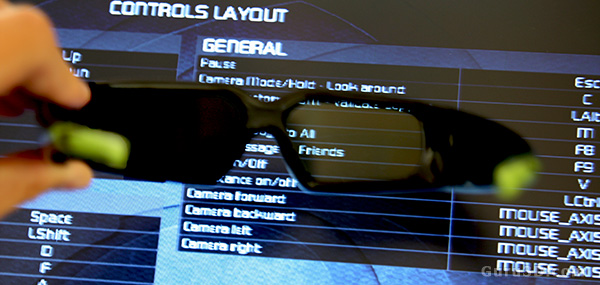NVIDIA's GeForce 3D Vision
NVIDIA's GeForce 3D Vision
So NVIDIA is using LCD shutter glasses which we just explained. Surely they are taking a proper approach, the quality of past glasses and the user experience has been average at best. With 60 Hz monitors we get 30 Hz to each eye usually, typically handicapping the overall experience. With this kit, everything changed as nVIDIA not only designed a funky user-friendly shutter glasses kit, they also combined it with 120 Hz monitor technology, and that is a big step forward.
Faster is good, lower equals flicker, preferably above 120 Hz (120 refreshes per second) = 60 Hz per eye.
Here's how that works, if we look at a monitor refreshing its screen 120 times per second, then our eyes can't track it anymore and we'll perceive a fuzzy 3D image. Now remember where we had to close our eyes in an alternating left - right sequence? Here's where 3D stereo goggles aka shutter glasses come in and do that job for you. What happens is that the monitor will display on each even frame an image for the left eye, and each odd frame for the right eye. That's 60 (even) frames per second for the left eye, and 60 odd frames per second for the right. The shutter glasses will blind one eye with the next in exactly that fashion as well, synchronized to the alternating sequence displayed on the LCD.
 Shutter glasses turn on and off glasses in an alternating frequency -- at 120 Hz each eye will perceive 60 Hz.
Shutter glasses turn on and off glasses in an alternating frequency -- at 120 Hz each eye will perceive 60 Hz.
So a 120 Hz LCD panel display option is the easiest to comprehend; if you have 120 frames per second of images then you can display 60 for each eye per second on the monitor.
When that grey matter of yours receives 60 frames of even and odd frames per second of material (alternating) we create an illusion... your brain merges the images, combines them and the perception of depth is in effect.
Now please bear in mind that with just a monitor and glasses you are not yet there. First off, your PC needs to be Windows 7 or Vista based in order for this kit to work. And then there's always hardware. You'll need a GeForce graphics card of the 8800 series, 9600 or 9800 series, or 200 series. Also bear in mind that if you buy this kit, you're forcing yourself into NVIDIA graphics cards for the future. Remember that if you want to upgrade to an ATI Radeon graphics card in the future, kiss your $200 3D kit goodbye as it's tied to GeForce drivers.
Requirements
- Beefy PC, strong GeForce graphics card solutions, GeForce GTX 260 or higher recommended.
- A supported monitor 110-120 Hz - for NVIDIA's kit you are restricted to the Samsung SyncMaster 2233RZ 120 Hz LCD display, or ViewSonic FuHzion VX2265wm 120 Hz LCD display or 100 Hz and higher analog CRTs. There are also some sets of DLP HDTV's supported.
- GeForce 3D Vision shutter glasses kit
- Windows Vista or Windows 7
So in our article we'll be showing some benchmarks as well on game performance, as this technology will place a hefty toll on graphics card performance. Where the game can be rendered in a normal fashion, for stereo technology the graphics card has to display two sets of images each for one of your eyes. Though graphics cards have become really fast over time, games have become more demanding as well. NVIDIA 3D Vision can place a 1.5x to 2x performance hit on your frame rate. So to achieve a decent frame rate we really do recommend the somewhat higher graphics cards like GeForce GTX 260 and above.
NVIDIA actually lists the GeForce 9600 GT as a starting point, but as our review will show, we'll test with a GeForce 8800 GTS / 9800 GTX / GTS 250 (roughly all the same) and with the kit monitor native at 1680x1050, you'll need something with a little more horsepower.
Anyway, let's have a closer look at the kit, first up the monitor and then the shutter glasses.

- 1680 by 1050 Native Resolution
- 300 cd/m2 Brightness
- 20,000:1 Dynamic Contrast Ratio
- 170o/160o (CR>10) Viewing Angle
- GTG 3ms (3D) / 5ms(2D) of Response Time
- 120Hz Dual Engine
- HDCP (High-Bandwidth Digital Content Protection)
- DVI-D (Digital Interface)
So you can purchase a GeForce 3D Vision shutter glasses kit at 199 EUR, but there's also a bundle available with a 3D ready 120hz monitor. That bundle will cost you give or take 475 EUR. The monitor then bundled will be this Samsung SyncMaster 2233RZ 120Hz LCD display.
